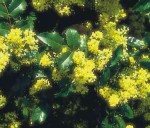 This suckering clump-forming evergreen shrub is native to damp forests from British Columbia to Oregon but grows well in many parts of the country. Slow growing, the shrub is upright to spreading and has a coarse texture. The leaves are pinnately compound and six to twelve inches long. New leaves emerge reddish or bronze, turn dark glossy green for summer, and then take on a purple bronze color in winter. They are spiny and resemble the leaves of English holly (Ilex aquifolium). Oregon grapeholly has striking yellow flowers that are borne at the end of branches in dense racemes two to three inches long, followed by purple fruits produced in bunches resembling grapes in late summer. The shrubs are attractive as a specimen or in a shrub border or foundation planting and are especially useful shady area where they are protected from hot sun and wind.
This suckering clump-forming evergreen shrub is native to damp forests from British Columbia to Oregon but grows well in many parts of the country. Slow growing, the shrub is upright to spreading and has a coarse texture. The leaves are pinnately compound and six to twelve inches long. New leaves emerge reddish or bronze, turn dark glossy green for summer, and then take on a purple bronze color in winter. They are spiny and resemble the leaves of English holly (Ilex aquifolium). Oregon grapeholly has striking yellow flowers that are borne at the end of branches in dense racemes two to three inches long, followed by purple fruits produced in bunches resembling grapes in late summer. The shrubs are attractive as a specimen or in a shrub border or foundation planting and are especially useful shady area where they are protected from hot sun and wind.
Type: Broadleaf evergreen flowering shrub
Outstanding Features: Foliage; flowers
Form: Upright, loose; colonizing
Growth Rate:Slow
Bloom: Yellow flowers are produced at the tops of branches on 2-3″ long racemes in spring and are followed by grape-like clusters of purple berries in fall.
Size: 3-6′ H x 3-8′ W
Light: Partial shade
Soil:Organic, moist, acid, cool
Hardiness: Zones 5-9
Care: Prune annually after flowering to maintain height
Pests and Diseases:None of significance
Propagation: Stratified seeds, cuttings, division
Outstanding Selection: ‘Compacta’ (2′).
